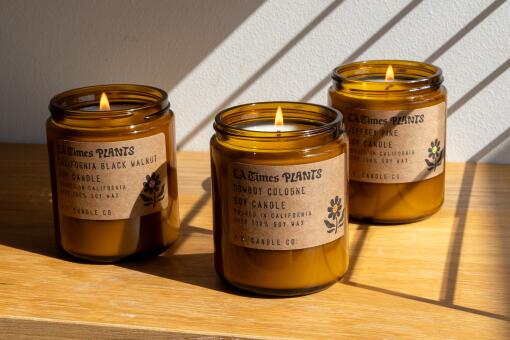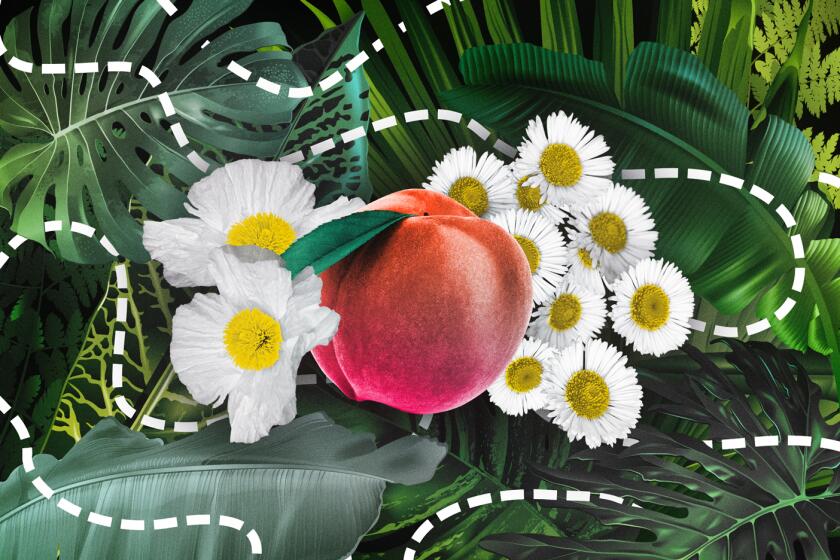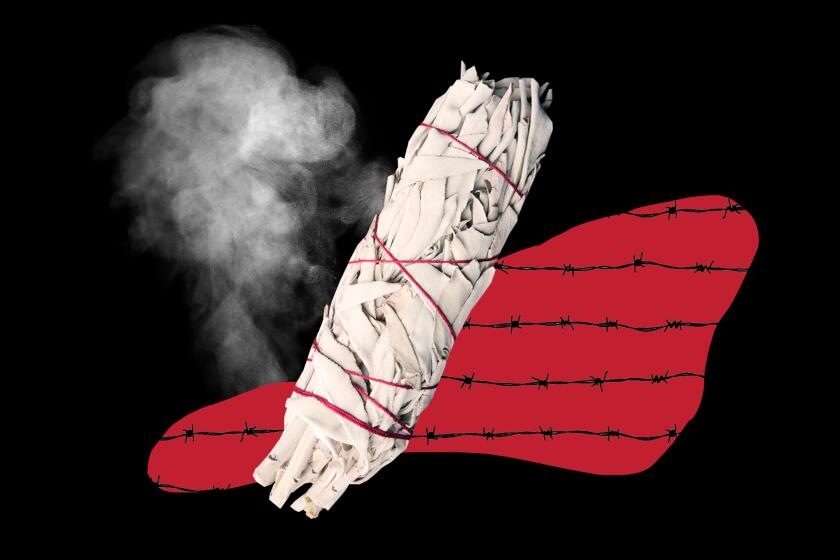Jasmine Floyd for The Times
Full disclosure: I wasn’t always a fan of California native plants because, honestly, I didn’t know anything about them. I was too busy being googly eyed over show-stopper ornamentals like roses.
My grandmother grew abundant roses as easily as I grow weeds, and I used to follow her in the garden as she cut huge bucketfuls for the cemetery (never for the living; I never saw a vase of flowers in her home). But as I lugged the buckets behind her, I’d put my nose in the growing bouquet and breathe in all those scents, some spicy, some rosy and some just honey sweet.
I loved the colors, yes, and their variety and form, but what really hooked me was their smell; almost like I could assimilate their grace with one big inhale.
L.A. Times Plants teamed up with
Los Angeles-based P.F. Candle Co. for a limited-edition candle collection that celebrates California native plants. They’re available at P.F. Candle Co. stores in Echo Park and North Beach or at pfcandleco.com.
It took many more years before I understood the power of fragrance on my mental health. I lived in central Washington then surrounded by orchards, and on crisp fall mornings, the thin, candy-sweet smell of ripening apples curled into my being like a drug. It made me happy, it gave me hope, for no good reason I could explain except for the scent.
And that, ultimately, is what lured me into the native plant world. These lean, scrappy plants are rarely as showy as their ornamental cousins, but when it comes to fragrance, they win every award, hands down.
That’s because drought-tolerant native plants have work to do. They can’t afford the pampered sterile beauty of a rose without pollen, as many hybrids are today. The natives are busy providing habitat to keep other creatures alive, offering up their branches and blooms as shelter and food in exchange for seed dispersal and pollination. It’s their raw, intense, sometimes overwhelming fragrance that entices butterflies and bees.
Hummingbird sage, for example, exudes a sugary cloud of scent at just the faintest touch. White sage is more restrained, but all it takes is a gentle rub of its silver leaves to release its distinctive savory smell. So yes, native plants save water and provide habitat. But imagine whole neighborhoods filled with their wild aromas, where happiness is just a gentle leaf rub away.
Finding your favorite nursery can be thrilling. Here are our picks for the best independently owned plant nurseries near Los Angeles.
I’m not the only one obsessed with these scents. Native plant fans rave endlessly about their fragrance. I contacted 13 experts in SoCal’s native plant world, asking for their five favorite-smelling plants, but most sent a list of 10 or more. They just couldn’t narrow it down. And while they agreed on a few, many of their picks were for different plants, some I’d never heard of, and am now eager to find.
Below is a list of the top 10 vote-getters, most of which are native plant standards every fragrance lover should have in their yards or on their patios. And following that are honorable mentions so you can try a few of both.
Our panel of experts includes Liv O’Keeffe, communications director for the California Native Plant Society; Lucinda McDade, executive director of the California Botanic Garden; landscape designers Shawn Maestretti and Leigh Adams of Studio Petrichor; Nicole Calhoun, owner of Artemisia Nursery; Mike Evans, president and co-founder of Tree of Life Nursery; Evan Meyer, executive director of the Theodore Payne Foundation; Madena Asbell, director of plant conservation programs, and Jessica Dacey, communications director of the Mojave Desert Land Trust; Carol Bornstein, native plant horticulturist and author; Mt. San Antonio College horticulture professor Chaz Perea and his landscaping team at the Dodger Stadium Botanic Garden; and Rose Ramirez and Deborah Small, producers of the documentary “Saging the World.”
A warning: Some of the recommendations may be hard to find, but the top vote getters should be easy to buy at any nursery that specializes in native plants. Or you can just wander these nurseries — touch and sniff to see which plants you like. Honestly, it’s harder to find a native plant that isn’t fragrant. Your job is to choose the ones whose aromas make you smile.
Here are the top 10 picks, in alphabetical order by their common names, but I’m including the scientific names too, to help you in your quest.
photos by Marc Kummel
1. California laurel (Umbellularia californica)
This handsome forest tree can grow from 6 to 60 feet tall in the right conditions, according to the native plant database CalScape. It also releases terpenes into the soil that can kill off many plants competing for its nutrients, so consider carefully where to put it in your yard. Or better yet, try growing it in a large (at least 24-inch) container on your patio, because when it comes to cooking, the leaves are spectacularly savory, especially when they’re crushed, says Evans. David Bryant, one-time education and engagement director for the California Native Plant Society, now communications director for the National Tropical Botanical Gardens in Hawaii, uses these native bay leaves to enhance soups, stews and especially macaroni and cheese. Just don’t leave it in too long, he says, because the flavoring can become too intense.
photos by Tim Becker
2. California sagebrush (Artemisia californica)
This silvery shrub is often called “cowboy cologne,” because, as the story goes, cowpokes of old would ride through stands of this pervasive aromatic brush to improve their personal aroma — back when showers and Old Spice weren’t readily available. These days, consider California sagebrush as a foundational native plant whose weediness can be tamed with a little judicious pruning while you’re inhaling the fragrance Evans calls “invigorating.” Its gray-green coloring sets it off nicely against darker green shrubs and its feathery foliage is lovely when backlighted by the sun. This plant is easy to grow and very drought tolerant; a good choice for sunny, sandy hillsides or lots . If you’re looking for a smaller variety, Perea and his crew recommend canyon gray sagebrush (Artemisia californica ‘Canyon Gray’), which is herby and slightly less pungent. Calhoun suggests a more riparian cousin, California mugwort, a.k.a. Douglas’ sagewort (Artemisia douglasiana): “The fragrance toes the line between sweet and savory, “ she wrote, “inhaling the aroma is anecdotally said to bring on prophetic dreams.”
photos by Erin Johnson
3. Cleveland sage (Salvia clevelandii)
The sage/salvia family is huge in the native plant world, and most are quite fragrant, but with aromas that range from tooth-achingly sweet to sharply savory Bornstein swears that Baja Blanca Cedros Island sage (Salvia cedrosensis ‘Baja Blanca’) has leaves that smell like chopped liver. She describes the smell as “a sensory reminder of my Jewish heritage.” Cleveland sage, her favorite and mine, falls happily in the middle, with a dusty, slightly honeyed perfume that is intense but never cloying. The silver green leaves make a nice counterpoint to deeper greens in the garden, and the purple flowers rise up like little pompoms on tall stems, cheerful and interesting whether fresh or dried. Calhoun recommends Pozo Blue sage (Salvia ‘Pozo Blue’), a hybrid of Cleveland sage and purple sage (Salvia leucophylla). “Something in the alchemy of blending these two savory sages resulted in a strongly scented yet slightly sweeter offspring,” says Calhoun.
photos courtesy of Theodore Payne Foundation
4. Coyote mint (Monardella villosa)
Imagine tall violet dandelion-like flowers that smell minty delicious, and you can picture coyote mint. The rounded, fluffy flowers come in bright violet or pink, and they’re endlessly cheerful, standing on tall stems like little sparklers. This perennial herb has small, neat leaves “that smell like a strong, pungent mint,” says McDade. Indigenous peoples used the plant as a remedy for upset stomachs, sore throats and respiratory problems, but it also works well steeped in hot water to make a soothing cup of mint tea.
Mark Boster / Los Angeles Times
5. Creosote bush (Larrea tridentata)
This is for all you desert dwellers out there — an airy green shrub with bright yellow flowers that mature into cottony fluff balls. But it gets its name, and inclusion on this list, because of its pungent chemical odor like, yes, creosote — a tar-based substance. The smell is especially strong when the leaves are wet, says McDade. “The Indigenous people of the desert say, ‘The desert smells like rain,’ and it is the fragrance of the creosote bush.” It’s drought-tolerant, no surprise, but also can manage soils high in salinity or alkaline, according to CalScape. It also has an interesting procreation technique. It reproduces by seed but also by sending up new shoots from the roots, creating “clonal rings” around the mother plant, such as the “King Clone Creosote” ring, which is estimated to be around 2,000 years old, in case you’re thinking of creating a legacy garden.
photos by Tim Becker; Mark Boster / Los Angeles Times
6. Desert lavender (Condea emoryi)
This leggy shrub has gray-green leaves and tall sprays of purple flowers that look sugar-frosted. Desert lavender grows natively throughout the deserts of the Southwest, and in California, around the Salton Sea. It prefers sandy, gravelly soils and very little water, but the heady fragrance of its flowers and leaves makes it a natural for potpourri mixes, says Evans, and Ramirez heartily agrees. “Desert lavender is probably my favorite,” she says. “I have about 10 plants that I dry and make into a bath tea. It is heaven!”
photos by Erin Johnson
7. Fragrant pitcher sage (Lepechinia fragrans)
If you love sweet, complex aromas, this is the plant for you. Despite its name, fragrant pitcher sage is a pale green mint, not a sage, with sprays of lavender, bell-shaped flowers popular with hummingbirds. And almost everyone praised it. “It’s sweet pungent, with delicate, long-lasting sweet aromas,” says Evans. “Notes of grapefruit,” says Calhoun. It flowers from spring through fall, and it grows quickly, according to CalScape, which recommends occasional light pruning to keep it from looking too wild.
photo by Marie Astrid Gonzalez
8. Hummingbird sage (Salvia spathacea)
There is nothing subtle about hummingbird sage. Its magenta blooms are tall and thick like exotic fruits, and if you happen to just graze a leaf, or drag a hose in its midst, the whole garden will be enveloped in its intoxicating perfume, sweet and powerful at the same time. Most of the fragrance comes from its large, light green leaves. It spreads easily, especially in its preferred habitat of dry shade or partial shade, like under a sprawling oak. Plant a couple, don’t overwater and wander through as often as you can for an aromatic pick-me-up. I can’t imagine my yard without some.
photos by Marie Astrid Gonzalez; Allen J. Schaben / Los Angeles Times
9. Woolly bluecurls (Trichostema lanatum)
And while we’re on the topic of sweet smells, woolly bluecurls wins the confectionary award hands down. Maestretti smells a cross between “bubble gum and sage.” Calhoun describes it as “grape candy.” Bornstein is more poetic: “The resinous leaves have an intoxicating fragrance.” I’d agree with all of those, plus this little proviso: Woolly bluecurls are great habitat plants, beloved by hummingbirds and other pollinators, but they are hard to keep alive. Water them the first year to get them established, but after that, they’re pretty much hydrophobes. Just a little summer water, more than once a month, can lead to their demise, according to CalScape. But don’t be discouraged, CalScape says. “Even if your woolly bluecurls only last a few years, they are worth it. They’ll grow to nearly full size within their first year, and start producing magnificent blue flowers soon after going into the ground.”
photos by Erin Johnson
10. White sage (Salvia apiana)
Southern California and northern Baja are the only places where white sage grows natively, and since our homes, businesses and roads have wiped out most of its native habitat, it feels only proper to plant some wherever we can. White sage grows so readily here that there’s absolutely no excuse for anyone in SoCal to be buying dried bundles for smudging; with their tall clusters of pale silvery leaves and arching spikes of white flowers streaked with lavender, they look dramatic in any setting. Since people all over the world purchase white sage for burning like incense, that should be a clue that this plant has an unmistakable aroma, lingering and sharp, nearly to the point of bitterness. It grows happily by my front door, nearly as tall as my 6-foot frame, and quietly commands my respect. When I compulsively stroke its leaves, I have to whisper thanks for the uplifting fragrance that will stay on my fingers for hours.
Poachers are stealing wild white sage at an alarming rate from its Southern California habitat and selling it to smudge stick makers. Here’s how to save the native plant.
Honorable mentions
Now, here are other fragrant native plants recommended by the experts. Several may be difficult to find in nurseries, but I’m including them here for the diehards (like me) who are just curious to know.
- San Diego yerba buena (Clinopodium chandleri)
- Yerba buena (Clinopodium douglasii)
- California mint / mountain mint (Pycnanthemum californicum)
- Black sage (Salvia mellifera)
- Cinchweed (Pectic papossa) — Meyer says this desert plant is “very rarely if ever available commercially... It has this very strong, almost cumin-like smell.”
- Dara’s choice sage (Salvia ‘Dara’s Choice’), a Salvia sonomensis hybrid
- Celestial blue sage (Salvia ‘Celestial Blue’), a rose sage hybrid
- San Miguel savory (Clinopodium chandleri), SoCal’s answer to yerba buena; sweetly clean and fresh, like spearmint
- California buckeye (Aesculus californica)
- California cudweed (Pseudognaphalium californicum) — Smells like maple syrup to McDade, but Bornstein, who also recommended this plant, is in the camp that smells curry
- Munz’s sage (Salvia munzii)
- California lilac (multiple varieties of ceanothus)
- Junipers
- Jeffrey pine, (Pinus jeffreyi ) — Bark smells of vanilla or butterscotch
- Hollyleaf cherry, (Prunus ilicifolia) — Leaves smell like amaretto
- Matilija poppy (Romneya coulteri)
- California lilac (multiple varieties of Ceanothus) — Some cultivars smell like corn tortillas
- Lilac verbena (Verbena lilacina) — Smells like baby powder
- Palmer’s penstemon (Penstemon palmeri), a.k.a grape soda penstemon; grape soda lupine (Lupinus excubitus) shares this sweet, fruity fragrance
- California wild rose (Rosa californica)
- California buckeye (Aesculus californica) — Intensely fragrant, sweetly scented flowers
- Sacred datura (Datura wrightii) — The crushed leaves smell like peanut butter
- Mojave sage (Salvia mohavensis)
- Turpentine broom (Thamnosma montana)
- Indigo bush (Psorothamnus arborescens)
- Mountain mint (Pycnanthemum californicum)
- Rose sage, a.k.a blue sage (Salvia pachyphylla).
Adams adds a benediction after sharing her favorites: “May all gardens emanate smells that make us stop and breathe a moment longer!”
My grandmother would like that.
More to Read
Sign up for The Wild
We’ll help you find the best places to hike, bike and run, as well as the perfect silent spots for meditation and yoga.
You may occasionally receive promotional content from the Los Angeles Times.














